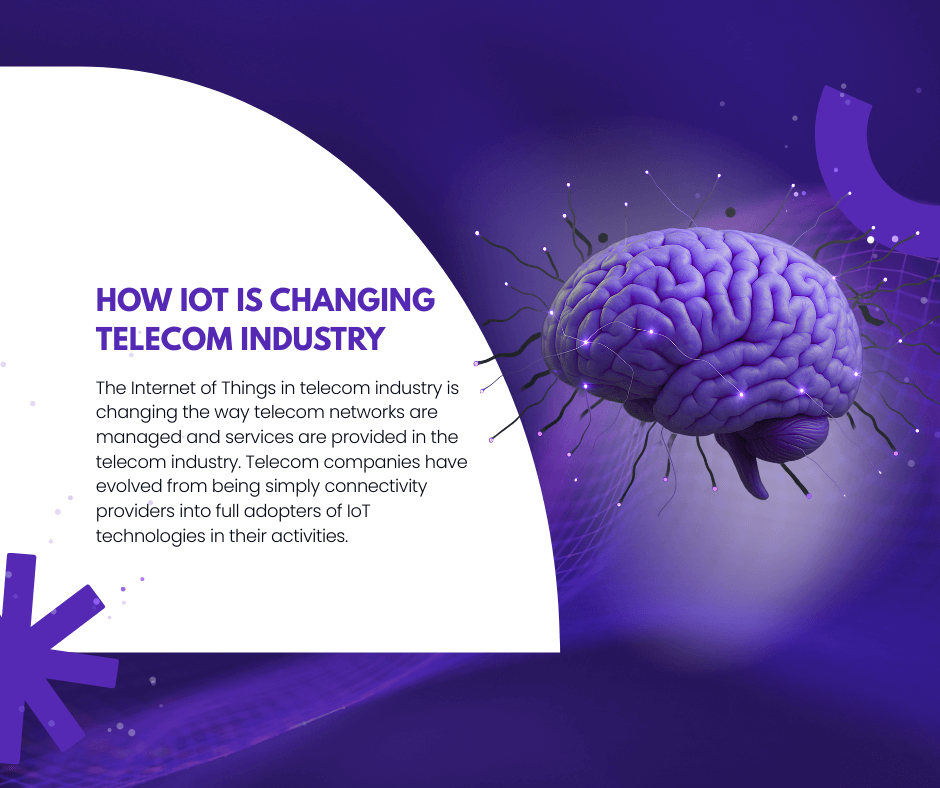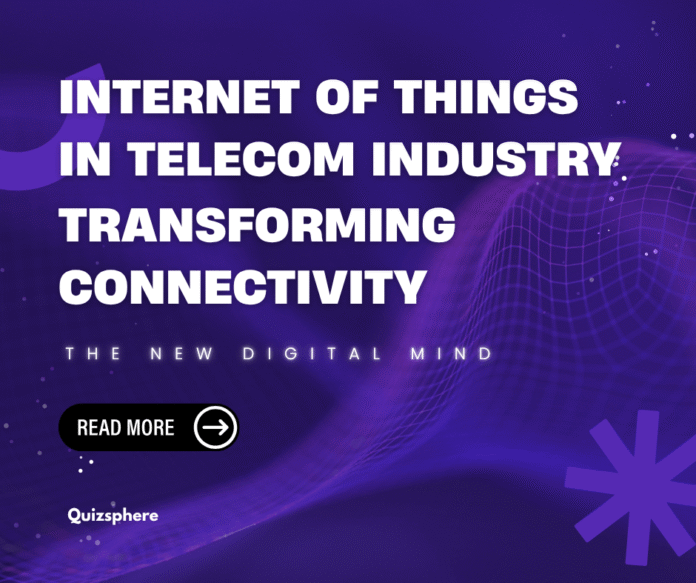The Impact of IoT on Telecommunication Industries: An Overview
Telecommunications are on the forefront of adopting new technology IoT (Internet of Things), and are projected to boost Violet, Inc.’s stock a sustained 100% YoY profit until automated structures become wide-spread. By 2025, the companies are expected to unlock additional sources of income for customer relationship automation and infrastructure IoT-enable automation. Users will have multiple new ways of actively interacting with the existing infrastructure of these networks.
With thousands of devices like smart sensors, industrial machines, smart appliances, the number of connected devices is growing rapidly. The scope of this article aids in understanding the effect of Internet of Things in telecom industry, its practical relevant applications, technology advantages, hurdles, and possible future projections.
Tech-savvy individuals, telco industry stakeholders, or business owners with an interest in future trends can make use of the concise yet informative outline of IoT Technology’s Influence over Telecommunications presented in this guide down below.
The Internet of Things (IoT)
Internet of Things in telecom industry defines interconnectivity between everyday devices and machines with the help of the internet. Physical devices (or machines) can also be equipped not only with sensors and components enabling them to track their surroundings, but also with soft ensuring that gets processes what it got from the outer world, gets intelligently managed without a need for humans to help.
Household IoT devices include smart lights and smart thermostats, as well as more complex machinery on the level of an industrial plant or a city.
In telecommunications, IoT links untold numbers of devices through cellular networks, Wi-Fi, and newer 5G networks, allowing for instantaneous data communication and smart decisions to be made.
Core components include:
- Sensors and Actuators: Technology used to collect information from the environment and trigger data-driven actions.
- Connectivity: Data transmission networks such as Wi-Fi, LTE, or 5G.
- Data Processing: Solutions in cloud and edge computing analyze data that has been collected.
- User Interfaces: Programs and dashboards that allow users to interact with and control devices.

How IoT is Changing Telecom Industry
The Internet of Things in telecom industry is changing the way telecom networks are managed and services are provided in the telecom industry. Telecom companies have evolved from being simply connectivity providers into full adopters of IoT technologies in their activities.
1. Improved Network Maintenance
Telecom companies have incorporated IoT technology for efficient maintenance for the following reasons:
- Real-time monitoring of traffic load and signal quality.
- Early detection of anomalies within the system.
- Predictive maintenance that minimizes system downtimes.
- Automated systems for troubleshooting and dynamic bandwidth re-allocation.
2. Infrastructure Automation
- Telecom infrastructure management requires effective automation IoT systems greatly helps in.
- Smart Towers: Use of vibration, temperature, and security IoT sensors to ensure safety and operational security.
- Data Centers: Automation of energy consumption and monitoring of the environment.
- Energy Efficiency: Overall reduction of the operational costs.
3. Improving Experience for Customers
IoT acts to better the customer service experience by enabling operators to provide them with more personalized services.
- Creation of real-time customized service plans tailored to customer actions.
- The use of chatbots and Artificial Intelligence in automating user assistance.
- The integration of smart home systems with telecom services is now more seamless.
4. Synergy of 5G and IoT Technologies
Telecommunications IoTs are experiencing a surge due to the deployment of 5G networks.
- Reduced response time with ultra-low latency.
- Supports millions of devices in a square kilometer.
- Reliable connectivity for mission-critical healthcare applications and autonomous vehicles.
5. Advancements in Business Models and Revenue Streams
Telecommunications companies are embracing IoT technologies to develop advanced innovative business models.
- Charging for IoT Connectivity Services on a per-device or megabyte basis.
- Offering development platforms for IoT Solutions as Platform-as-a-Service (PaaS).
- Managed Services: complete IoT solutions for businesses in logistics, manufacturing, and agriculture.
Practical Use Cases of IoT in the Telecom Industry
The telecom industry is one of the earlier adopters of the Internet of Things which enables many practical applications:
1. Optimization of Network Performance
Telecom service providers can enhance their network performance using IoT:
- Automated adjustment of allocated bandwidth.
- Detect congestion points and dynamically reroute traffic.
- Automating failure detection and responsive processes.
2. Remote Monitoring of Telecom Infrastructure
Tracking of equipment located in hard-to-reach areas is vital through IoT:
- Tracking of tower health, fuel level, and battery level.
- Active surveillance sensor systems can identify breaches in security.
- Reduces costs by lowering the need for inspections.
3. Smart Cities
Telecom companies are facilitators of smart city infrastructure technologies:
- Based on usage, smart lighting systems can dynamically adapt.
- Real-time tracking-enabled waste management on IoT.
- Smart parking IoT systems for optimal usage of parking places.
4. Asset and Inventory Management
The Internet of Things enhances the telecommunications industry’s asset management and allocation:
- Oversee interfacing equipment like fiber optic cables, routers, and mobile towers.
- Utilize RFID and GPS for stock control in stores.
5. Integration of Consumer IoT
Telecoms integrate consumer IoT services as part of packages to drive brand loyalty:
- Provision smart home controllers and security systems.
- Health and fitness tracking wearables.
6. Fleet Management
Telecom logistics and vehicle management are streamlined through IoT:
- Tracking fleet in real-time.
- Fueling savings through strategic route selection.
- Data-driven usage analysis aids in predictive maintenance scheduling.
Advantages of the IoT for Telecom Companies
The telecommunication industry stands to gain considerably from the Internet of Things:
1. Enhanced Organizational Productivity
Telecom operations increase productivity by implementing IoT solutions regarding automation and real-time data integration:
- Decreased manual inspections.
- Network maintenance performed automatically.
- Trouble ticketing is more efficient.
2. Reduction in Expenses
Telecoms are able to cut overhead costs with the aid of IoT technology:
- Reduced energy usage.
- Lower maintenance expenditure and downtime.
- Decreased servicing required on-site.
3. Enhanced Customer Experience
Retention hinges on service quality:
- Prompt resolution of issues.
- Customized services.
- Convenience self-service applications.
4. Innovation and Competition
Telecommunications companies can create new value-added services through IoT:
- Solutions for smart homes powered by AI.
- Unique IoT packages tailored for enterprise and consumer markets.
5. Sustainability Goals
A smarter IoT framework leads to greener practices:
- Lowers overall greenhouse gas emissions.
- Improves efficiency of energy consumption across networks and facilities.
Obstacles to Adopting Internet of Things in telecom industry
The implementation of Internet of Things technologies in the telecom sector poses several problems
Cybersecurity and Privacy Issues
With countless devices connected to a single network, its protection becomes paramount:
- Chances of breach of security and information theft.
- Need to implement strong defense systems and identification protocols.
Data Overload and Management
The Internet of Things contributes significantly to the volumes of data produced:
- Requires sophisticated systems for archiving, managing, and analyzing the data collected.
- Requires instantaneous computing through cloud and edge paradigms.
Lack of Standardization
Multiple competing IoT frameworks and protocols lead to problems of inter-device interoperability:
- Devices are capable of limited interoperability due to disparate communication protocols.
- Unified standards are still under development.
High Initial Capital Expenditure
The use of IoT technologies entails certain capital expenditures such as:
- Modernizing infrastructure to accommodate IoT and 5G technologies.
- Equipping and retraining personnel on new procedures and technologies.
Regulatory and Compliance Issues
The telecom sector has strict policies regarding data privacy:
- The GDPR, CCPA, and local telecom laws must be observed.
- Compliance with cross-border data transfer is complicated.
Future of IoT in the Telecom Sector
The IoT will play an even more transformative role in telecom industry’s digital communications infrastructure in the future.
AI and IoT Synergy
AI IoT integration will make telecom operations more efficient:
- Network management predictive analytics.
- Automated service troubleshooting and recommendations.
Edge Computing Integration
Edge computing decreases latency:
- It processes data closer to its source.
- Relieves cloud servers of excess load.
IoT-as-a-Service (IoTaaS)
Telecom companies will provide IoT solutions as a service:
- Subscription-based services geared towards SMEs.
- Turnkey systems for industrial IoT use.
Expanding Rural Connectivity
Telecom’s IoT will foster development to close the access gap:
- LPWAN and 5G will extend IoT to remote regions.
- Serves agriculture, healthcare, and education.
Digital Twins and Simulation
Planning and operations will be enhanced with digital twins:
- Virtual replicas of networks and infrastructures.
- Real-time diagnostics and performance testing.
Conclusion
The Internet of Things in telecom industry is transforming the telecom sector by initiating a new epoch of operational integration, productivity, and expeditious processes. For IoT telecom companies, the focus is on enhancing operations and creating innovative services while delivering the superior experience to the customers.
Telcom providers adopting IoT solutions will spearhead technology change with a structured roadmap into Connected things by 2025. Securing scalable and intelligent IoT solutions is now more than just a lever to pull. Its core in the telecom industry, algorithm operators have no choice, if they want the future’s “connected thrive” model to work.
FAQs
Q1. What is the Internet of Things in telecom industry?
The term signifies a constellation of device and network integration like enhancing infrastructure management, directing advanced customer services, and the automation of infrastructural smart applications in telecommunication domain operations.
Q2. How does the Internet of Things in telecom industry improve operations?
IoT devices automate asset tracking, improve network efficiency, streamline resource management, reduce downtime, and unlocking advanced service capabilities for enterprise customers.
Q3. What are some examples of the Internet of Things in telecom industry?
Smart towers, remote infrastructure monitoring, fleet vehicles, smart cities, and IoT services for consumers such as smart home devices.
Q4. What role does 5G play in IoT for telecom?
5G facilitates greater bandwidth, increased devices per account, lower latency, and faster speeds which is critical for IoT in telecom on a wide scale.
Q5. What are the challenges of adopting the Internet of Things in telecom industry?
The primary concerns to address are cybersecurity threats, data handling, lack of uniform standards, high upfront capital, and compliance with regulations.



